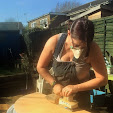You may or may not know that I have signed up for the 365 project this year. The plan was to restore a sense of balance after the disastrous tail end of last year skewed my perspective on the whole year. When I come to look back on 2011, if there is pictorial evidence of the wonders of some days and the total ordinariness of others, perhaps the bleak days will seem less significant. That's the theory, anyway.
Initially, I set out just to capture a moment from each day, journal style. But then I saw the quality of some of the work in other people's projects and found myself trying to emulate their standards, when I had neither the equipment nor the skills to do so. After a few failed days of that nonsense, I reminded myself to 'run my own race' and went back to the photo journal idea. I chose to follow other members with the same sort of approach, to keep things in perspective.
But yesterday, I surprised myself.
I took my dog for a walk along the River Nene that runs through our town, and took photos as I went. If you're a Facebook friend, you can see the whole set. When I got home, I popped the camera card into my laptop to look at the photos and was really very impressed with the result. Even with just a little point and shoot (Kodak DX6490) my first picture of the day turned out to be as near perfect as anything I have ever done.
So there are two ways of looking at this.
Either: I have no idea how I achieved that, so I learned nothing. This is entirely true.
Or: I have stumbled upon evidence that I can actually do good work. Really good work. Knowing that I can, inspires me to try to do it again... only on purpose next time.
A little accidental success goes a long way.



2 comments:
This actually reminds me of something I've been thinking of lately as my students expect me to "teach them how" rather than giving them opportunities to learn.
Many times, because of our inner critic, we are afraid to just let the situation go where it will, using a gut feeling. The difference between my husband's photos and mine, for example, is that I will take dozens with the hope that one or two will come out "perfect". I don't wait, but just DO. He tries to set up his perception of what perfect would be so he misses that odd photo where someone has such glee on their face. I'm looking at a picture I took when my son was 18 months old where he is smelling the flowers. It is perfect. It only took me about 10 different shots to capture.
So my question to you is, how to you get students to just let go and try things, knowing they may end up being total disasters? How do you get them to quiet their inner critic until AFTER they've experienced something they will learn from?
@Virginia Ah, the 64 million dollar question! That mindset is the result of generations of a results-focused education system, where getting it right is what counts, not the process by which we achieve that rightness. Or so I believe anyway. We have become so fixated on results that we have lost the courage to experiment.
I attended a presentation recently where the speaker said something along the lines of "the fear of failure is the enemy of success." We learn so much from failure. That presentation was part of the Learning Technologies conference and a key theme that emerged was how grossly undervalued failure is in our current culture.
I think we are limited in the extent to which we can make a difference, but we could do worse than praise students for trying, even (especially?) when they fail.
At the risk of entering into forbidden territory, all my childhood I had known the story of the disciple Peter trying to walk on water and sinking. Oh, how we scorned him! Oh, what a loser he was! I was an adult before it occurred to me to realise that Peter was the only one who got out of the boat. Sure, he sank, but he walked on water first! Meantime, the eleven real losers were sitting in the boat. Whether or not you believe that story, it serves as an analogy, here.
The trick is to achieve that mindset with the students: that the real loser is the one who doesn't try. I wish I had the magic recipe switch on that particular light!
Post a Comment